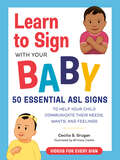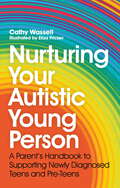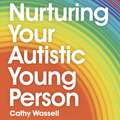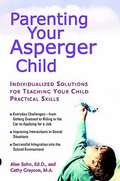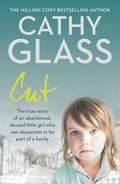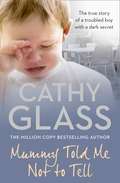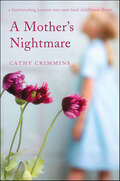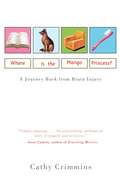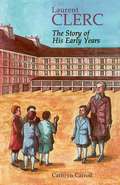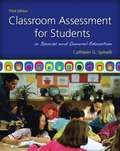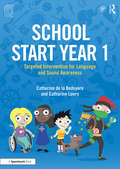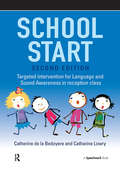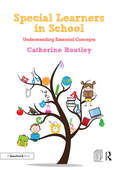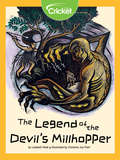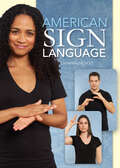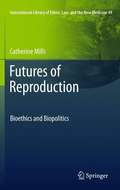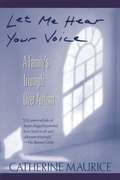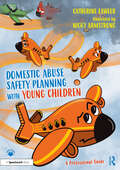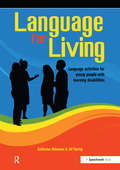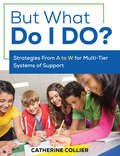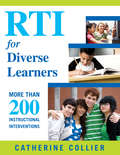- Table View
- List View
Learn to Sign with Your Baby: 50 Essential ASL Signs to Help Your Child Communicate Their Needs, Wants, and Fe elings
by Cecilia S. GruganCommunicate, connect, and bond with your baby with 50 essential, easy-to-learn ASL signs.Your baby is crying. Are they hungry or are they tired? With 50 practical ASL signs that cover a child&’s day, Learn to Sign with Your Baby will help you better understand your child and help them communicate with you. Author Cecilia S. Grugan, a Deaf parent, gives you detailed instructions and tips for how to master each sign, as well as helpful advice and fun activities for incorporating ASL into your life with baby. And with clear illustrations and video demonstrations for each sign, you can confidently start signing with your baby—and watch as your bond deepens and strengthens.Learn to Sign with Your Baby includes: 50 of the most useful ASL signs. From &“more&” and &“eat&” to &“change&” and &“hurt,&” this book teaches the most relevant and practical terms for your daily life with baby—and makes signs for specific needs easy to find.Step-by-step color illustrations and video for every sign. The video for each sign can be accessed by a QR code; scan it for step-by-step guidance to confidently and correctly form each sign.Engaging activities make ASL fun. Play a game, sing a song—this book makes incorporating ASL into your life enjoyable and rewarding.Helpful tips. Tips for remembering the signs, how to effectively use them, and what to look for as baby signs back make ASL easy to learn and easy to use.
A Boy and a Jaguar
by Catia Chien Alan RabinowitzAlan loves animals, but the great cat house at the Bronx Zoo makes him sad. Why are they all alone in empty cages? Are they being punished? More than anything, he wants to be their champion--their voice--but he stutters uncontrollably.Except when he talks to animals...Then he is fluent. This real-life story with tender illustrations by Catia Chien explores truths not defined by the spoken word. <br><b>2015 Schneider Family Book Award Winner </b>
Nurturing Your Autistic Young Person: A Parent’s Handbook to Supporting Newly Diagnosed Teens and Pre-Teens
by Cathy WassellAs the parent of a child recognised as autistic as a pre-teen or teen, it can often feel difficult to find the answers you need. Children who make it to late primary/early secondary age before being picked up by the system tend to present with traits that are harder to spot, meaning it can be harder to engage professionals in the diagnostic process and gather the necessary support.Cathy Wassell, CEO of Autistic Girls Network, has tailored this handbook to support parents with older children or teenagers who are at the identification stage, walking them through the basics in an engaging and accessible manner. She addresses key challenges for this age group, including co-occurring conditions, puberty, and safeguarding, as well as looking to the future, advising on schooling options, and beyond.Designed to help parents become fully informed and ensure a nurturing and positive environment for our autistic young people, this is a guide with a focus on difference - not deficit.
Nurturing Your Autistic Young Person: A Parent’s Handbook to Supporting Newly Diagnosed Teens and Pre-Teens
by Cathy WassellAs the parent of a child recognised as autistic as a pre-teen or teen, it can often feel difficult to find the answers you need. Children who make it to late primary/early secondary age before being picked up by the system tend to present with traits that are harder to spot, meaning it can be harder to engage professionals in the diagnostic process and gather the necessary support.Cathy Wassell, CEO of Autistic Girls Network, has tailored this handbook to support parents with older children or teenagers who are at the identification stage, walking them through the basics in an engaging and accessible manner. She addresses key challenges for this age group, including co-occurring conditions, puberty, and safeguarding, as well as looking to the future, advising on schooling options, and beyond.Designed to help parents become fully informed and ensure a nurturing and positive environment for our autistic young people, this is a guide with a focus on difference - not deficit.
Parenting Your Asperger Child
by Cathy Grayson Alan SohnAsperger's Syndrome is a form of autism--but with the right guidance, these children can go on to live happy, fulfilling lives. In Parenting Your Asperger Child, Dr. Alan Sohn's and Cathy Grayson's groundbreaking Cognitive Social Integration Therapy (CSIT) offers practical solutions that help parents prepare their children for a fulfilling life of social interaction outside the confines of their syndrome, addressing such topics as: - The six characteristics of Asperger's Syndrome - How to identify a child's type of Asperger's--and the best approaches for dealing with it - Understanding how an Asperger's child sees and interprets the world - Replacing inappropriate coping techniques with productive skills - How to survive and learn from a crisis - How school programs can aid in teaching Asperger children - Making changes that last
Cut: The True Story of an Abandoned, Abused Little Girl Who Was Desperate to Be Part of a Family
by Cathy GlassDawn was the first girl Cathy Glass ever fostered. A sweet and seemingly well balanced girl, Dawn's outward appearance masked a traumatic childhood so awful, that even she could not remember it. During the first night, Cathy awoke to see Dawn looming above Cathy's baby's cot, her eyes staring and blank. She sleepwalks--which Cathy learns is often a manifestation in disturbed children. It becomes a regular and frightening occurrence, and Cathy is horrified to find Dawn lighting a match whilst mumbling "It's not my fault" in her sleep one night. Cathy discovers Dawn is playing truant from school, and struggling to make friends. More worryingly she finds her room empty one night, and her pillow covered in blood. Dawn has been self-harming in order to release the pain of her past. When Dawn attempts suicide, Cathy realises that she needs more help than she can give. Dawn's mother eventually confides in her that Dawn was sent away to relatives in Ireland between the ages of 5 and 9, and came back very disturbed. She also sheds light on the reason for Dawn's fascination with matches and Cathy's baby. *SPOILER ALERT*SPOILER INFO FOLLOWS* Eventually Dawn is placed in a psychiatric home for children, and five years later she gets in touch with Cathy. She has been reconciled with her mother and is now training to become a teacher.
Mummy Told Me Not to Tell: The True Story of a Troubled Boy with a Dark Secret
by Cathy GlassReece is the last of six siblings to be fostered. Having been in care for four months his aggressive and disruptive behaviour has seen him passed from carer to carer. Although only 7, he has been excluded from school, and bites people so often that his mother calls him 'Sharky'. Cathy wants to find the answers for Reece's distressing behaviour, but he has been sworn to secrecy by his mother, and will not tell them anything. As the social worker prepares for the final hearing, he finds five different files on Reece's family, and is incredulous that he had not been removed from them as a baby. When the darkest of family secrets is revealed to Cathy, Reece's behaviour suddenly starts to make sense, and together they can begin to rebuild his life.
A Mother's Nightmare: A Heartrending Journey into Near Fatal Childhood Illness
by Cathy CrimminsIn the tradition of Lorenzo's Oil, a brutally searing story of one mother's quest to save her child's life.One day Kelly Crimmins was a happy seemingly healthy twelve-year-old; the next she confessed to her mom that she'd had blood in her urine for months. After a series of tests, Kelly was diagnosed with a life-threatening, potentially terminal autoimmune disease.A Mother's Nightmare details Cathy and Kelly's three-year medical and emotional journey, which took them from Philadelphia to Minnesota's Mayo Clinic and back again. Cathy writes about the toll taken on a young girl who suddenly becomes a patient, and about a mom who in fighting for her little girl's life becomes sick herself with worry and fear. As she did in her award-winning Where Is the Mango Princess?, Cathy makes illness both personal and universal. It's an account all readers will find memorable and moving.
Where Is the Mango Princess? A Journey Back from Brain Injury: A Journey Back From Brain Injury
by Cathy CrimminsHumorist Cathy Crimmins has written a deeply personal, wrenching, and often hilarious account of the effects of traumatic brain injury, not only on the victim, in this case her husband, but on the family.When her husband Alan is injured in a speedboat accident, Cathy Crimmins reluctantly assumes the role of caregiver and learns to cope with the person he has become. No longer the man who loved obscure Japanese cinema and wry humor, Crimmins' husband has emerged from the accident a childlike and unpredictable replica of his former self with a short attention span and a penchant for inane cartoons. Where Is the Mango Princess? is a breathtaking account that explores the very nature of personality--and the complexities of the heart.
Laurent Clerc: The Story of His Early Years
by Cathryn CarrollLaurent Clerc won lasting renown as the deaf teacher who helped Thomas Hopkins Gallaudet establish schools to educate deaf Americans in the 19th century. Now, his character as a young boy growing up in Paris has been captured in the novel Laurent Clerc. In his own voice, Clerc vividly relates the experiences that led to his later progressive teaching methods. Especially influential was his long stay at the Royal National Institute for the Deaf in Paris, where he encountered sharply distinct personalities -- the saintly, inspiring deaf teacher Massieu, the vicious Dr. Itard and his heartless "experiments" on deaf boys, and the "Father of the Deaf," Abbe Sicard, who could hardly sign. Young adult readers will find his story richly entertaining as well as informative.
Classroom Assessment for Students in Special and General Education (Third Edition)
by Cathleen G. SpinelliClassroom Assessment for Students in Special and General Education is written for future teachers and experienced educators who are interested in developing or expanding their understanding of effective and reflective assessment practices. This new edition, with its emphasis on progress monitoring and early intervention, aligns well with the practical, authentic, and informal assessment procedures that have been--and continue to be--the heart of this edition and of past editions of this text.
School Start Year 1: Targeted Intervention for Language and Sound Awareness (School Start)
by Catherine de la Bedoyere Catharine LowryThis highly practical resource is designed to be used with children who need additional help in developing communication skills in Year 1. It offers a carefully structured group intervention which can be delivered by teachers or teaching assistants and is designed to boost language and sound awareness skills School Start Year 1 includes: detailed advice on how to set up the programme and identify children who may benefit; a structured programme of 30 Language group sessions; a structured programme of 30 Sound Awareness group sessions; activities and learning objectives that link with the Primary curriculum; 56 resource templates that can be photocopied or downloaded from the website; templates to monitor each child’s objectives and an end of year evaluation. Activities are supported by colourful and original illustrations to engage children’s interest and are themed around topics such as animal antics, detective stories and the seaside. An additional 5 template sessions are provided which can be used to extend the programme into Year 2. The authors provide clear guidance on how to use the resources and include an FAQ section for schools, parents and Speech and Language Therapists. This latest resource is a follow on to the hugely popular School Start and Pre-School Start and has been successfully piloted in schools. This is an invaluable resource for primary school staff that encourages good collaborative practice between teachers, teaching assistants, inclusion co-ordinators, SENCOs, speech and language therapists and parents.
School Start: Targeted Intervention for Language and Sound Awareness in Reception Class, 2nd Edition (School Start)
by Catherine de la Bedoyere Cath LowryThis is a practical resource that can be used with children who need additional help in developing communication skills during the first year of school and is a follow-on from the hugely successful first edition. This second edition focuses primarily on a targeted group intervention, to boost the language and sound awareness skills of children entering reception class, who are delayed in these areas of communication. It also addresses aspects of attention, following instructions and social communication.School Start, aims to help children catch up so that they may be ready to access the learning environment of Year 1. It is an invaluable resource for teachers and teaching assistants that encourages good collaborative practice between schools, speech & language therapists, the SENCO and parents. The programme consist of: an initial six-week period so that educational staff may identify children of concern; a screening checklist to confirm the identification of those children a structured programme of 30 Language group sessions that teaching assistants will find quick and easy to follow, delivered once a week a structured programme of 30 Sound Awareness group sessions that teaching assistants will find quick and easy to follow, delivered once a week activities and learning objectives linked into communication at home and in class monitoring of each child's objectives and readministration of the checklist in July. Teachers and teaching assistants first select children suitable for the programme through the checklists provided; set-up meetings then take place between the inclusion coordinator and school before the child is enrolled on the programme. Devised by two speech & language therapists experienced in working with teaching staff, the book consists of two 30-week programmes aimed at developing Language and Sound Awareness skills. Each six-week block has clearly written objectives that are linked to the National Curriculum Foundation Stage. Baseline and evaluation checklists are also provided to monitor each child's progress.School Start offers: an introduction on how to use the School Start programme group sessions for the Language and Sound Awareness programmes 70 photocopiable resource templates programme delivery templates containing all the checklists, record sheets and handouts needed to carry out the programme an accompanying CD-Rom giving the option to print out some of the resource templates in colour. Successfully trialled over a three-year period, School Start is an invaluable resource for teachers and teaching assistants that encourages good collaborative practice between schools, speech & language therapists, the school's inclusion coordinator and parents.
Special Learners in School: Understanding Essential Concepts
by Catherine RoutleyOffering a wealth of photocopiable resources for use with individual children or small groups, Special Learners in School provides a step-by-step programme to help practitioners support children with a range of special educational needs, and develop the skills which are fundamental to their learning in the mainstream classroom. Competencies including active listening and observation skills, memory, comprehension of pattern and sequencing, positional and expressive language, body awareness and emotional intelligence are all key to ensuring a child’s access to the school curriculum. Recognising that these can be particular areas of difficulty for pupils with SEND, this book provides a range of activities designed to engage and gradually develop children’s use of auditory and visual memory, pragmatic and sensory skills. Easily accessible and differentiated for children at lower and upper levels of ability, practical examples and activities can be used immediately, or be adapted in line with students’ abilities and progress. This will be an invaluable source of inspiration and activites for learning support assistants, teaching assistants, teachers and SENCOs looking to support children in mainstream schools as they develop skills fundamental to their learning.
The Legend of the Devil’s Millhopper
by Catherine RossPotano, the chief of the Timucua people, must save his daughter from a demon. Together with his strongest warriors, he must overcome the demon's challenges. Will he be able to rescue his daughter? Or will they fail after they fall into the Devil’s Millhopper?
American Sign Language
by Catherine NicholsIt's the third most used language in the United States-and yet it's "spoken" without even opening your mouth! It's estimated that as many as two million Americans speak American Sign Language, a method of communication that's both fun and useful, even if you or your friends and family are not hearing impaired.American Sign Language uses simple-to-follow photographs to teach you the alphabet, numbers, and simple words and phrases. Divided into categories such as Animals and People and Pronouns, the book and accompanying flashcards show you how to use your hands to communicate. Once you've learned the alphabet, you'll build on that knowledge to learn the words for "friend" and "family." And when you how the words for "chicken" and "cat" evoke a chicken opening and closing its beak and a cat stroking its whiskers, you'll truly understand how intuitive and enjoyable learning American Sign Language can be.Learning a new language is always a rewarding endeavor-and with American Sign Language, it's easier than ever!
Futures of Reproduction: Bioethics and Biopolitics
by Catherine MillsIssues in reproductive ethics, such as the capacity of parents to 'choose children', present challenges to philosophical ideas of freedom, responsibility and harm. This book responds to these challenges by proposing a new framework for thinking about the ethics of reproduction that emphasizes the ways that social norms affect decisions about who is born. The book provides clear and thorough discussions of some of the dominant problems in reproductive ethics - human enhancement and the notion of the normal, reproductive liberty and procreative beneficence, the principle of harm and discrimination against disability - while also proposing new ways of addressing these. The author draws upon the work of Michel Foucault, especially his discussions of biopolitics and norms, and later work on ethics, alongside feminist theorists of embodiment to argue for a new bioethics that is responsive to social norms, human vulnerability and the relational context of freedom and responsibility. This is done through compelling discussions of new technologies and practices, including the debate on liberal eugenics and human enhancement, the deliberate selection of disabilities, PGD and obstetric ultrasound.
Let Me Hear Your Voice: A Family's Triumph Over Autism
by Catherine MauriceShe was a beautiful doe-like child, with an intense, graceful fragility. In her first year, she picked up words, smiled and laughed, and learned to walk. But then Anne-Marie began to turn inward. And when her little girl lost some of the words she had acquired, cried inconsolably, and showed no interest in anyone around her, Catherine Maurice took her to doctors who gave her a devastating diagnosis: autism. In their desperate struggle to save their daughter, the Maurices plunged into a medical nightmare of false hopes, "miracle cures," and infuriating suggestions that Anne-Marie's autism was somehow their fault. Finally, Anne-Marie was saved by an intensive behavioral therapy. Let Me Hear Your Voice is a mother's illuminating account of how one family triumphed over autism. It is an absolutely unforgettable book, as beautifully written as it is informative. "A vivid and uplifting story ... Offers new strength to parents who refuse to give up on their autistic children." -- Kirkus Reviews. "Outstanding ... Heartfelt ... A lifeline to families in similar circumstances." -- Library Journal.
Domestic Abuse Safety Planning with Young Children: A Professional Guide (Safety Planning with Young Children)
by Catherine LawlerThis guidebook is an essential companion to the Pilgrim’s Bumpy Flight story and is designed to be read by professionals to ensure the effective and safe use of the storybook. Pilgrims Bumpy Flight has been created to help young children aged 5–7 experiencing domestic abuse, to explore the concepts of physical and emotional safety. Safety planning with a child offers a way to help them vocalise their feelings and understand what to do when something does not feel right. The professional guide will help supporting adults facilitate safety planning that is experienced as emphatically curious, safe and where the child’s opinion matters. It provides up-to-date information on domestic abuse, childhood trauma, practice tips and how to complete a safety plan with a young child using the storybook as the key vessel of communication and exploration. Key features include: • Accessible information about domestic abuse and coercive control based on the latest research. • Guidance around direct work and safety planning with young children. • Practical activities building off Pilgrim’s story, including printable material. • Things to consider and ways to use the storybook to facilitate a conversation with a child, as well as page-by-page helpers notes on the narrative. • A comprehensive list of helplines and organisations in place to support adult victims/survivors of domestic abuse. Used alongside the storybook, this professional guide is a crucial tool for the early years sector, education staff and those working in children’s services, including safeguarding officers, family support workers, social workers and children’s IDVAs. Both books should be used in tandem with agency policy, procedure and guidance.
Language for Living: Communication Activities for Young Adults with Learning Difficulties
by Catherine DelamainThis title features communication activities for young adults with learning difficulties. This unique collection of 180 enjoyable group activities aims to foster both the skills underlying communication, such as body language and awareness of others, and aspects of spoken language itself. The activities fall broadly within the Entry Levels 1-3 of the Skills for Life Core Curriculum, but can be used as a completely independent programme. The book addresses the needs of students with very varied skill levels, and includes some activities which can be used with non-verbal students. "Language for Living" has the following advantages: no formal assessment necessary; equipment not required or kept to a minimum; activities can be freely adapted to suit students' lifestyles and experience; activities are simple to organise, and easy to fit in to the daily programme of college, day or residential settings; photocopiable resource section; and CD-ROM for optional record-keeping and printable resources.
Goodbye Hamilton
by Catherine CooksonA continuation of Maisie's story, and she still feels the need for her imaginary horse Hamilton. Her deformed arm makes it hard for her to defend herself, and it seems that she is destined to have sorrow with a small amount of happiness.
But What Do I DO?: Strategies From A to W for Multi-Tier Systems of Support
by Catherine C. CollierIdentifying appropriate strategies for instruction or intervention made easy! Select individualized and evidence-based interventions for struggling students with this comprehensive guide. Organized around an alphabetized and cross-referenced list and a fold-out selection grid featuring more than 150 PBIS, RTI and MTSS interventions, you’ll quickly find the tools to resolve specific learning and behavioral challenges. You’ll learn to Meet the needs of all your struggling students including at-risk, culturally and linguistically diverse, as well as those with IEPs Progress monitor, document, and modify instructional strategies Identify specific interventions for distinct learning and behavior problems Implement in variety of settings, including special education, learning assistance programs, and full-inclusion
But What Do I DO?: Strategies From A to W for Multi-Tier Systems of Support
by Catherine C. CollierIdentifying appropriate strategies for instruction or intervention made easy! Select individualized and evidence-based interventions for struggling students with this comprehensive guide. Organized around an alphabetized and cross-referenced list and a fold-out selection grid featuring more than 150 PBIS, RTI and MTSS interventions, you’ll quickly find the tools to resolve specific learning and behavioral challenges. You’ll learn to Meet the needs of all your struggling students including at-risk, culturally and linguistically diverse, as well as those with IEPs Progress monitor, document, and modify instructional strategies Identify specific interventions for distinct learning and behavior problems Implement in variety of settings, including special education, learning assistance programs, and full-inclusion
RTI for Diverse Learners: More Than 200 Instructional Interventions
by Catherine C. CollierProvide targeted instruction to ELLs and other diverse learners! Many Response to Intervention (RTI) models were developed to identify specific learning disabilities in English-speaking students. This research-based resource provides more than 200 instructional interventions for using RTI with students from culturally and linguistically diverse backgrounds in Grades K–12, especially non-native English speakers and those with limited English proficiency. This book features: Interventions for students' cognitive, behavior, literacy, and communication issues at each tier of a multi-tier RTI framework A reader-friendly format and straightforward directions for using each intervention Examples from practice and a glossary to aid implementation
